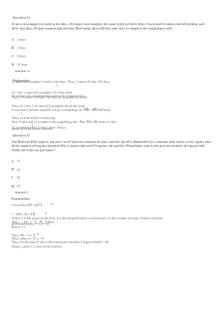RTH 120 chapter 4 questions Solved PDF

| Title | RTH 120 chapter 4 questions Solved |
|---|---|
| Author | Nawal Lahlou |
| Course | Concepts Of Personal & Community Health |
| Institution | Northern Virginia Community College |
| Pages | 3 |
| File Size | 73.1 KB |
| File Type | |
| Total Downloads | 88 |
| Total Views | 126 |
Summary
Download RTH 120 chapter 4 questions Solved PDF
Description
Souad Bannani Chapter 4: Vital signs
1-All of the following are included in the measurement of vital signs, except which one? a. Pulse b. Respiratory rate c. Urinary output d. Blood pressure 2-Which of the following changes is consistent with a fever? a. Decreased respiratory rate b. Increased pulse rate c. Decreased oxygen consumption d. Decreased blood pressure 3-Which of the following methods of temperature measurement is recommended for neonates? a. Oral b. Axillary c. Rectal d. Ear 4-What is the normal value of the resting pulse rate in the adult? a. 30-60 beats/min b. 60-100 beats/min c. 80-120 beats/min d. 100-150 beats/min 5-What is the normal range of the respiratory rate for adults? a. 6-10 breaths/min b. 8-12 breaths/min c. 12-20 breaths/min d. 15-25 breaths/min 6-Which of the following causes tachycardia in the adult? a. Hypothermia b. Hypoxemia
c. Hypertension d. Polycythemia 7-Which of the following arterial sites is the most common for evaluating the pulse in the adult patient? a. Pedal b. Temporal c. Radial d. Femoral 8-Which of the following causes tachypnea in the adult? a. Hypothermia b. Narcotic overdose c. Metabolic acidosis d. Hyperoxia
9-Which of the following causes an erroneously low blood pressure measurement? a. Inflation pressure held in the cuff between measurements b. Use of blood pressure cuff that is too narrow c. Not enough pressure used in the cuff during measurement d. Tachycardia 10-Hypotension may often be associated with all of the following, except which one? a. Reduced perfusion b. Less oxygen delivery to the tissues c. Excessive salt intake d. Dehydration 11-The peak pressure in the arteries is known as which of the following? a. Pulse pressure b. Diastolic pressure c. Systolic pressure d. Pulse pressure 12-A decrease in the intensity of the palpated pulse during inhalation is a definition of which of the following?
a. Abdominal paradox b. Pulse pressure c. Pulsus paradoxus d. Pulsus alternans 13-What is the normal range for pulse pressure? a. 10-20 mm Hg b. 20-25 mm Hg c. 30-50 mm Hg d. 35-40 mm Hg 14-If a patient experiences syncope when moving from the supine to the upright position, what is the likely cause? a. Left ventricular failure b. Postural hypotension c. Excessive vasoconstriction d. Pulsus paradoxus...
Similar Free PDFs

Solved-questions-digital
- 157 Pages

Solved Question Paper (4)
- 10 Pages

Math 120 Quiz 1 Questions
- 1 Pages

Exercise Questions Chapter 4
- 6 Pages

Chapter 4-6 Questions
- 29 Pages

Chapter 4 Review Questions
- 1 Pages

Chapter 4 - MCQ Questions
- 14 Pages

Chapter 4 review questions
- 11 Pages

Chapter 4 questions
- 2 Pages

Chapter 4 Questions Muscular
- 9 Pages

Chapter 4 Questions
- 2 Pages

Chapter 4 TY Questions
- 1 Pages

Chapter 4 (Review Questions)
- 4 Pages

Lab 4 - ATMS 120 Lab 4
- 7 Pages
Popular Institutions
- Tinajero National High School - Annex
- Politeknik Caltex Riau
- Yokohama City University
- SGT University
- University of Al-Qadisiyah
- Divine Word College of Vigan
- Techniek College Rotterdam
- Universidade de Santiago
- Universiti Teknologi MARA Cawangan Johor Kampus Pasir Gudang
- Poltekkes Kemenkes Yogyakarta
- Baguio City National High School
- Colegio san marcos
- preparatoria uno
- Centro de Bachillerato Tecnológico Industrial y de Servicios No. 107
- Dalian Maritime University
- Quang Trung Secondary School
- Colegio Tecnológico en Informática
- Corporación Regional de Educación Superior
- Grupo CEDVA
- Dar Al Uloom University
- Centro de Estudios Preuniversitarios de la Universidad Nacional de Ingeniería
- 上智大学
- Aakash International School, Nuna Majara
- San Felipe Neri Catholic School
- Kang Chiao International School - New Taipei City
- Misamis Occidental National High School
- Institución Educativa Escuela Normal Juan Ladrilleros
- Kolehiyo ng Pantukan
- Batanes State College
- Instituto Continental
- Sekolah Menengah Kejuruan Kesehatan Kaltara (Tarakan)
- Colegio de La Inmaculada Concepcion - Cebu

